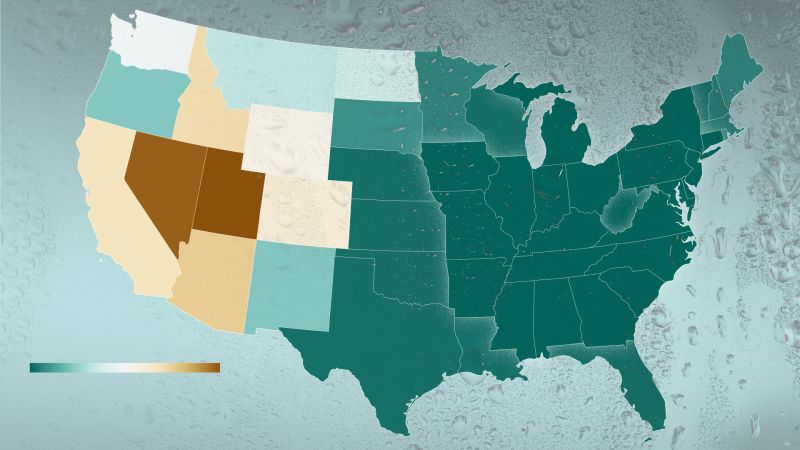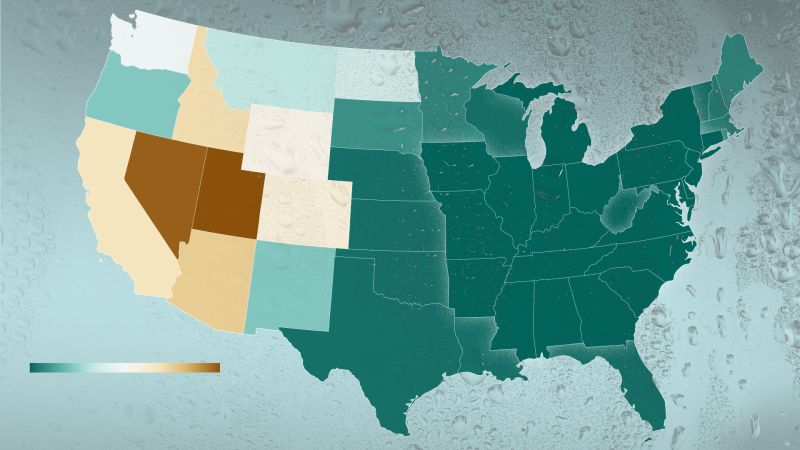Sticky Summer: Breaking Down The Science Of Extreme Humidity

Welcome to your ultimate source for breaking news, trending updates, and in-depth stories from around the world. Whether it's politics, technology, entertainment, sports, or lifestyle, we bring you real-time updates that keep you informed and ahead of the curve.
Our team works tirelessly to ensure you never miss a moment. From the latest developments in global events to the most talked-about topics on social media, our news platform is designed to deliver accurate and timely information, all in one place.
Stay in the know and join thousands of readers who trust us for reliable, up-to-date content. Explore our expertly curated articles and dive deeper into the stories that matter to you. Visit Best Website now and be part of the conversation. Don't miss out on the headlines that shape our world!
Table of Contents
Sticky Summer: Breaking Down the Science of Extreme Humidity
Summer's here, and for many, that means battling the dreaded humidity. That clinging, uncomfortable feeling? It's more than just a nuisance; it's a scientific phenomenon with real-world impacts. This article delves into the science behind extreme humidity, exploring its causes, effects, and what you can do to stay comfortable during those sticky summer days.
What is Humidity, Anyway?
Humidity refers to the amount of water vapor present in the air. Warm air can hold significantly more water vapor than cold air. When the air is saturated – meaning it's holding the maximum amount of water vapor it can at a given temperature – we experience high humidity. This saturation point is crucial because it directly impacts our comfort levels.
The Science of "Stickiness": Relative Humidity and Dew Point
While humidity is often discussed in terms of absolute humidity (the actual amount of water vapor), two other measures are more relevant to our perception of stickiness:
- Relative Humidity: This expresses the amount of water vapor in the air as a percentage of the maximum amount the air could hold at that temperature. High relative humidity (above 60%, often much higher in humid climates) means the air is close to saturation.
- Dew Point: This is the temperature at which the air becomes saturated and water vapor begins to condense into liquid water (dew). A higher dew point indicates more moisture in the air and, consequently, a stickier feeling. A dew point above 65°F (18°C) is generally considered uncomfortable for most people.
Why Does Humidity Feel So Uncomfortable?
That clammy, sticky feeling isn't just psychological. High humidity inhibits our body's natural cooling mechanism – sweating. When we sweat, the evaporation of sweat from our skin cools us down. However, in humid conditions, the air is already saturated with water vapor, slowing down or preventing evaporation. This trapped moisture leaves us feeling hot, sticky, and uncomfortable.
Health Impacts of Extreme Humidity
Beyond discomfort, high humidity can have significant health consequences:
- Heatstroke: The reduced evaporative cooling effect increases the risk of heatstroke, a serious and potentially life-threatening condition.
- Respiratory problems: High humidity can exacerbate respiratory conditions like asthma and allergies, as it can promote mold and mildew growth.
- Increased risk of infections: Humid conditions provide ideal breeding grounds for various bacteria and viruses.
Coping with Sticky Summer Conditions:
While you can't control the weather, you can take steps to mitigate the effects of high humidity:
- Stay hydrated: Drink plenty of water throughout the day to help regulate your body temperature.
- Dress appropriately: Wear lightweight, loose-fitting clothing made from breathable fabrics.
- Use air conditioning: Air conditioning effectively removes moisture from the air, providing significant relief. Consider investing in a dehumidifier for extra comfort.
- Seek out shaded areas: Limit sun exposure during the hottest parts of the day.
- Take cool showers or baths: This can provide temporary relief from the heat and humidity.
Conclusion:
Understanding the science behind humidity helps us better cope with its effects during those sweltering summer months. By implementing these strategies, you can make those sticky summer days a little more bearable. Remember to prioritize your health and well-being during periods of extreme heat and humidity. Stay informed about heat advisories and take precautions to protect yourself from heat-related illnesses. Stay cool and stay safe!

Thank you for visiting our website, your trusted source for the latest updates and in-depth coverage on Sticky Summer: Breaking Down The Science Of Extreme Humidity. We're committed to keeping you informed with timely and accurate information to meet your curiosity and needs.
If you have any questions, suggestions, or feedback, we'd love to hear from you. Your insights are valuable to us and help us improve to serve you better. Feel free to reach out through our contact page.
Don't forget to bookmark our website and check back regularly for the latest headlines and trending topics. See you next time, and thank you for being part of our growing community!
Featured Posts
-
 Jennifer Holland On Peacemaker Season 2 Working With John Cena
Aug 14, 2025
Jennifer Holland On Peacemaker Season 2 Working With John Cena
Aug 14, 2025 -
 Halos Face Setback Outfielder Injury And Passing Of Former Angel Impact Team
Aug 14, 2025
Halos Face Setback Outfielder Injury And Passing Of Former Angel Impact Team
Aug 14, 2025 -
 Terry Crews Daughter Defends Nepo Baby Status In Viral Video
Aug 14, 2025
Terry Crews Daughter Defends Nepo Baby Status In Viral Video
Aug 14, 2025 -
 Summers Extreme Humidity Causes And Effects Explained
Aug 14, 2025
Summers Extreme Humidity Causes And Effects Explained
Aug 14, 2025 -
 Government Faces Backlash Over Inheritance Tax Changes Amidst Migrant Crisis
Aug 14, 2025
Government Faces Backlash Over Inheritance Tax Changes Amidst Migrant Crisis
Aug 14, 2025
Latest Posts
-
 Vandenberg Space Force Base Space X Launch Status And Updates
Aug 14, 2025
Vandenberg Space Force Base Space X Launch Status And Updates
Aug 14, 2025 -
 Jennifer Holland On Peacemaker Season 2 Working With John Cena Sets The Tone
Aug 14, 2025
Jennifer Holland On Peacemaker Season 2 Working With John Cena Sets The Tone
Aug 14, 2025 -
 Injury Update Bryce Teodosio Plays Sunday
Aug 14, 2025
Injury Update Bryce Teodosio Plays Sunday
Aug 14, 2025 -
 Classic Cars And Huge Crowds Revisiting Monterey Car Week 1997
Aug 14, 2025
Classic Cars And Huge Crowds Revisiting Monterey Car Week 1997
Aug 14, 2025 -
 Throwback Thursday Massive Crowds At Monterey Car Week 1997
Aug 14, 2025
Throwback Thursday Massive Crowds At Monterey Car Week 1997
Aug 14, 2025
